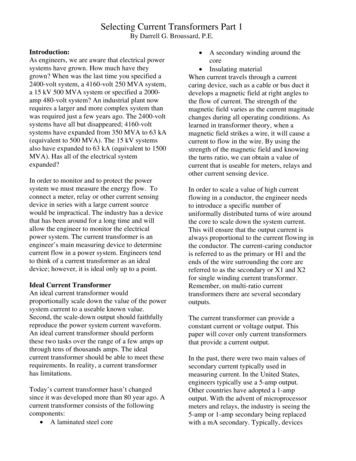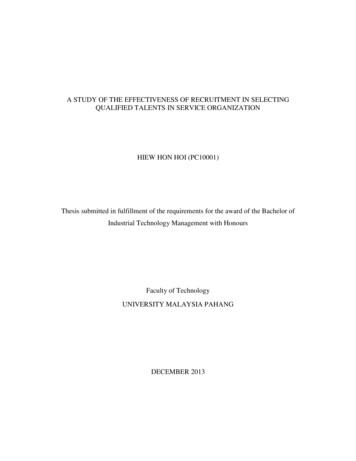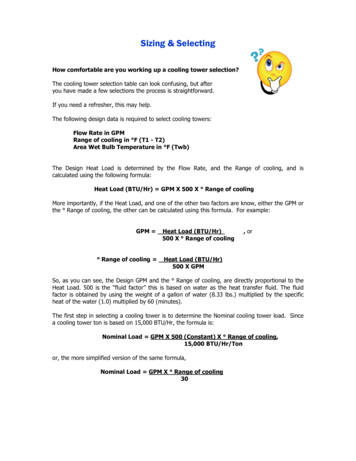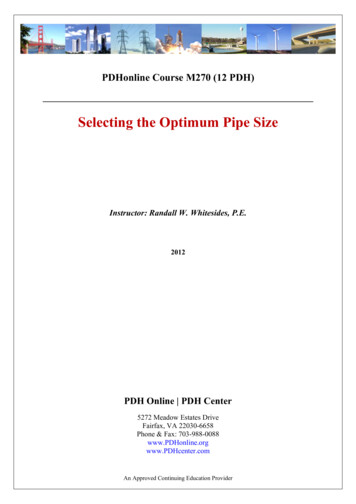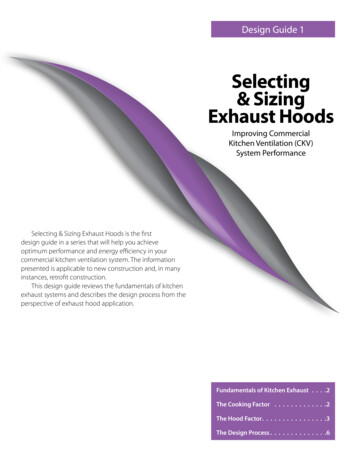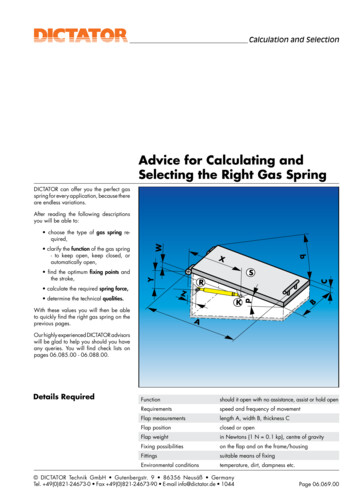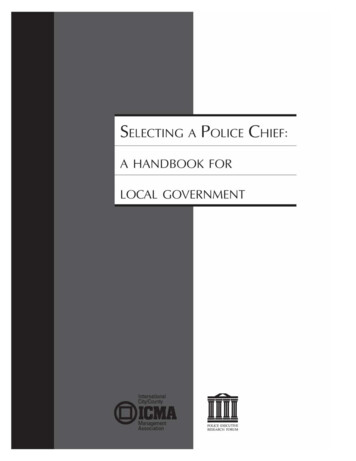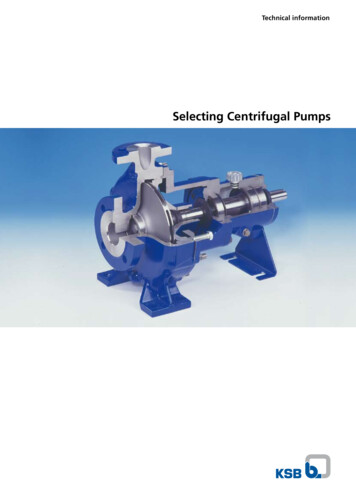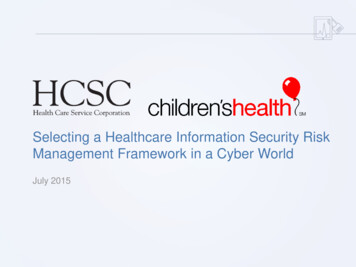
Transcription
Selecting a Healthcare Information Security RiskManagement Framework in a Cyber WorldJuly 2015
The Need For A Healthcare InformationSecurity Risk Management Framework2
Risk Management FrameworksGiven increasing regulatory pressure to ensure the adequate protection of ePHI and a dynamic cyberthreat environment that is increasingly hostile to the industry, we believe it is incumbent upon allhealthcare entities to adopt a formal risk management framework to ensure all reasonably anticipatedthreats to ePHI are formally addressed.An information security risk management framework provides a set of principles, tools and practices tohelp organizations: Ensure people, process and technology elements completely and comprehensively addressinformation and cybersecurity risks consistent with their business objectives, including legislative,regulatory and best practice requirements Identify risks from the use of information by the organization’s business units and facilitate theavoidance, transfer, reduction or acceptance of risk Support policy definition, enforcement, measurement, monitoring and reporting for each component ofthe security program are adequately addressedHowever, there are multiple information security risk management frameworks from which to choose,including but not limited to: HITRUST CSF and supporting programs, tools and methodologies ISO/IEC 27001, 27002 and supporting 27000-series documents NIST SP 800-53 r4 and supporting 800-series documents3
Healthcare Framework Requirements (1)To aid in the selection of an appropriate information security risk management framework for healthcareentities, we believe the selected framework should meet the following requirements: The framework should provide comprehensive coverage of general security requirements for theprotection of ePHI specified in the HIPAA Security Rule under § 164.306(a) and § 164.308(a)(1)(ii),including best practices such as those specified in the NIST Framework for Improving CriticalInfrastructure Cybersecurity (NIST Cybersecurity Framework) The framework should address and harmonize relevant business and compliance requirements,e.g., from applicable federal and state statues and regulations, including the HIPAA Security Rule’sstandards and implementation specifications. Since the HIPAA Security Rule’s standards andimplementation specifications are generally high-level, the framework should provide prescriptivecontrols (safeguards), i.e., the control requirements should be detailed enough for a healthcareentity to understand what must be implemented in the intended environment to adequately addressthe threat(s) The framework’s controls should be practical for a healthcare entity to implement and maintain andscalable based on the size and type of organization or information system being protected The framework should allow for the flexibility of approach specified in the HIPAA Security Rule under§ 164.306(b) and support a risk-based rather than a compliance-based selection of a reasonableand appropriate set of controls4
Healthcare Framework Requirements (2)Requirements (continued): The framework should be fully supported and maintained by a sponsoring third-party organizationto ensure its continued relevance to the healthcare industry and the threat environment The controls and implementation, assessment and reporting methodologies should be vetted byhealthcare organizations and industry experts such as leading professional services firms via anopen and transparent update process The controls specified in the framework should be supported by detailed audit or assessmentguidance that helps ensure the consistency and accuracy in evaluation and reporting regardlessof the specific assessor used The framework should employ an assessment approach and scoring methodology that makes theframework certifiable for implementing organizations, i.e., it supports the formal certification of animplementing healthcare entity against the framework’s controls The framework should allow an organization to assess once and report many, i.e., an assessmentmust address multiple compliance and best practice requirements (e.g., the HIPAA Security Rule andNIST) and support the reporting of assurances tailored to each requirement The framework should provide robust support for third party assurance using common,standardized assessment and reporting processes that can be tailored to the specific requirements ofthe requesting organization5
Selecting Candidate Risk ManagementFrameworks for Detailed Analysis6
Candidate FrameworksIncluding consideration of the HIPAA Security Rule, there are six (6) generally recognized and acceptedframeworks that can be considered reasonable candidates from which to build an organization-levelinformation security risk management program: COBIT: Provides a set of recommended best practices for governance and control processes forinformation systems and technology, one aspect of which is the control of information system andtechnology risk HIPAA: Although issued as a regulation, the HIPAA Security Rule provides a series of securitystandards and implementation specifications, including the requirements for organizations toconduct a risk analysis and protect against all reasonably anticipated threats HITRUST: Formed specifically to support the healthcare industry, the HITRUST risk managementframework is detailed in the HITRUST CSF, CSF Assurance Program and supported by multipledocuments (e.g., the HITRUST Risk Analysis Guide) and tools (e.g., MyCSF) ISO: International in scope, ISO/IEC 27001 and 27002 provide a comprehensive if high-levelbaseline set of controls that can be implemented by any type of organization; supporting 27000series publications provide the rest of the information security risk management framework, andhealthcare specific considerations are specifically addressed in ISO/IEC 27799 NIST: Although intended for federal agencies, the NIST SP 800-53 controls and supporting 800series publications provides a comprehensive and detailed information security risk managementframework and three control baselines that can be applied to low, moderate and highimpact/sensitive information; healthcare specific considerations are also addressed in NIST SP 80066 PCI: Although intended for payment card information, the PCI DSS framework is comprehensiveenough in scope to provide a reasonable baseline for the protection of any type of sensitiveinformation7
“Down-selecting” Candidate FrameworksThe following table provides an initial comparison of the six (6) candidate frameworks based onthe specified requirements:RequirementCSFCOBITPCI DSSISONISTHIPAAComprehensive coverageYesYesYesYesYesPartialHarmonizes relevant business and compliancerequirementsYesNoNoNoNoNoPrescriptive controlsYesYesYesPartialYesNoPractical and scalable controlsYesYesNoNoNoYesRisk-based rather than d and maintained by a third partyYesYesYesYesYesNoVetted by healthcare and industry expertsYesNoNoYes**Yes**NoOpen and transparent update processYesNoYesYesYesYesDetailed audit or assessment guidanceYesYesYesYesYesNoConsistency and accuracy in evaluationYesPartialPartialPartialYesNoCertifiable for implementing organizationsYesYesYesYesPartial*NoAssess once and report manyYesNoNoPartial***Partial***NoSupport for third-party assuranceYesYesYesYesPartial*No*NIST controls are typically certified by a specific information system or type of system rather than at the organizational-level** ISO 27799 and NIST SP 800-66 both subject to comment period prior to release*** ISO and NIST are considered “benchmark” frameworks by which many other frameworks are measured and often mappedBased on the results outlined in the table, more detailed analysis can be limited to three candidateframeworks: CSF, ISO and NIST8
Detailed Analysis of CandidateRisk Management Frameworks9
Comprehensive CoverageThe framework should provide comprehensive coverage of general security requirements for theprotection of ePHI specified in the HIPAA Security Rule under § 164.306(a) and § 164.308(a)(1)(ii),including best practices such as those specified in the NIST Framework for Improving CriticalInfrastructure Cybersecurity (NIST Cybersecurity Framework).NIST SP 800-53 controls were designed specifically for U.S.government agencies, but NIST SP 800-53, as well as ISO/ IEC27001, also provides information security standards that areapplicable to a very broad scope of environments andorganizations. And while neither ISO nor NIST address the specificneeds of any single industry, they do discuss the application of theirframeworks in a healthcare setting in separate documents: ISO/IEC27799 and NIST SP 800-66.The HITRUST CSF, on the other hand, provides an integrated setof comprehensive security safeguards derived from multipleregulatory requirements applicable to U.S. healthcare , such as theHIPAA Omnibus Security, Data Breach Notification and PrivacyRules, as well as generally accepted information security standardsand best practices, including ISO/IEC 27001 and NIST SP 800-53.HITRUST provides a healthcare-specific implementation of theNIST Cybersecurity Framework and either meets or exceeds itsguidelines for the NIST Framework Core, NIST Framework Profiles,and NIST Framework Implementation Tiers. The completeHITRUST risk management also addresses non-cyber threats toePHI and incorporates a robust assurance program, alsorecommended by the NIST Cybersecurity Framework.10
Harmonizes Relevant RequirementsThe framework should address and harmonize relevant business and compliance requirements,e.g., from applicable federal and state statues and regulations, including the HIPAA SecurityRule’s standards and implementation specifications.The HITRUST framework is based on the ISO/ IEC 27001 control clausesto support the implementation and assessment of information security andcompliance risk for offshore business associates, and NIST requirementsrelevant to healthcare information protection are fully integrated into theCSF. Relevant requirements from other authoritative sources such as theHIPAA Security, Data Breach Notification and Privacy Rules, COBIT, NISTSP 800-63, NIST SP 800-66, ISO/IEC 27799 and PCI DSS are also fullyintegrated into the 3 implementation levels contained in the CSF.Requirements that may be specific to an information type (e.g., paymentcard data or federal tax information) or to an organization type (e.g., a CMScontractor or Health Information Exchange) are segregated into “industrysegments” and can be made available as needed. In this way healthcareorganizations can use a single control framework, the CSF, as the basis fortheir entire information security program.11
Prescriptive ControlsSince the HIPAA Security Rule’s standards and implementation specifications are generally highlevel, the framework should provide controls (safeguards) that are prescriptive, i.e., they should bedetailed enough for a healthcare entity to understand what must be implemented in the intendedenvironment to adequately address the threat(s).HIPAA’s Security Rule provides numerous standards implementation specifications that essentially requirecovered entities to implement reasonable and appropriate administrative, technical and physical safeguards forePHI. Unfortunately, HIPAA lacks the level of prescriptiveness necessary to determine a standard of due careor diligence, i.e., what safeguards would be considered “reasonable and appropriate,” or ensure the consistentapplication of these safeguards.Although ISO controls are also relatively high-level and lack the prescription contained in the NIST framework,the HITRUST CSF integrates all relevant ISO and NIST controls along with additional requirements from relativeauthoritative sources like the NIST Cybersecurity Framework, CSA CCM, COBIT, PCI DSS, CMS IS ARS,MARS-E and IRS Pub 1075.12
Practical and Scalable ControlsThe framework’s controls should be practical for a healthcare entity to implement and maintainand scalable based on the size and type of organization or information system being protected.ISO/IEC 27001 provides high-level requirements that may be liberally tailored by an implementing organization.NIST provides more prescriptive controls and generally limits tailoring to the definition of certain controlparameters. Although NIST encourages adding controls to address additional threats or mitigate more risk,NIST discourages removing or relaxing control requirements once a baseline has been selected. There is simplyno formal mechanism by which the controls can be scaled to the size or type of organization implementing theNIST framework. Subsequently all the requirements contained in a specific NIST baseline may not always beappropriate to a non-governmental entity.HITRUST addresses the practicality and scaling of CSF controls by tailoring the complete set of CSF controlrequirements to the healthcare industry and then creating overlays for specific classes of healthcareorganizations based on organizational, system and regulatory risk factors.13
Risk-based Rather than Compliance-basedThe framework should allow for the flexibility of approach specified in the HIPAA Security Ruleunder § 164.306(b) and support a risk-based rather than a compliance-based selection of areasonable and appropriate set of controls.ISO allows organizations to select or modify the controls from its single baseline quite liberally but with no realoversight over the process. NIST provides for a specific methodology for tailoring its three baselines, includingthe development of industry/sector or organizational overlays. However NIST also does not provide anyoversight over the process.HITRUST adopts the NIST methodology and tailors the controls in the CSF based on healthcare industryrequirements, essentially creating a healthcare-specific overlay of the integrated, harmonized requirementsderived from its multiple authoritative sources. HITRUST then provides for the creation of additional overlays forspecific classes of healthcare entities based on defined organizational, system and regulatory risk factors.This provides healthcare organizations with an initial control baseline that better suits the healthcare industry aswell as the specific needs of the organization.It is only after the organization completes the tailoring process that HITRUST then requires a complianceoriented approach to the implementation, maintenance and assessment of the assigned controls. Deficienciesthen determine excessive residual risk to the organization’s information assets and allows the development andprioritization of corrective actions.14
Supported and Maintained by a Third PartyThe framework should be fully supported and maintained by a third-party organization to ensureits continued relevance to the healthcare industry and the threat environment.HITRUST maintains the relevancy of the CSF by regularly reviewing changes in source frameworks and bestpractices due to changes in the regulatory or threat environment. The CSF is updated no less than annually,whereas updates to ISO/IEC 27001 and NIST SP 800-53 are made much less frequently and may notnecessarily reflect new federal or state legislation and regulations (e.g., recent omnibus HIPAA rulemaking orTexas House Bill 300). The ongoing enhancements and maintenance to the CSF provide continuing value tohealthcare organizations, sparing them from much of the expense of integrating and tailoring these multiplerequirements and best practices into a custom framework of their own.15
Vetted by Healthcare and Industry ExpertsThe controls and implementation, assessment and reporting methodologies should be vetted byhealthcare organizations and industry experts such as leading professional services firms.Although NIST and ISO controls are not vetted specifically by healthcare and industry experts such asprofessional services firms, drafts are open for a public comment period in which anyone can provide input.The HITRUST CSF on the other hand was created by healthcare and industry experts, content from newauthoritative sources is typically developed by industry working groups or based on industry and CSF AdvisoryCommittee input, and all content for each annual release is made available to healthcare and industry expertsfor comment.16
Open and Transparent Update ProcessThe controls and implementation, assessment and reporting methodologies are subject to anopen and transparent update process.All three organizations—ISO, NIST and HITRUST—release updates to their frameworks for public comment.ISO and NIST may take years to update their standards but HITRUST updates the CSF no less than annuallyand each release is specifically made available to healthcare and industry experts, including professionalservices firms, for comment. Additional sources for integration into the CSF are based on industry and CSFAdvisory Committee input.ISO and NIST both provide summaries of changes, either in the document or separately, and NIST generallyprovides a redlined copy of the document. HITRUST releases a detailed summary of changes with each newrelease that clearly indicates each addition, deletion or modification to the CSF structure or content along withthe relevant authoritative source and the reason the addition, deletion or modification was made.Recent updates: Release v6.1 in Apr 2014 integrated the NIST Cybersecurity Framework Release v7 in Jan 2015 incorporated MARS-E and HIPAA-based privacy requirements for general use(previously only available for SecureTexas certification)17
Detailed Audit or Assessment GuidanceThe controls specified in the framework should be supported by detailed audit or assessmentguidance that helps ensure the consistency and accuracy in evaluation and reporting regardlessof the specific assessor used.By its very nature, ISO’s assessment methodology is very general in order to support global applicability in awide variety of industry segments. ISO/IEC 27005 provides some guidance for risk assessment and analysis,but does not provide or recommend a specific methodology. The NIST Risk Management Framework (RMF), onthe other hand, provides very specific guidance on a multitude of topics, including the implementation,maintenance, assessment and reporting of an information security risk management program. However, withthe possible exception of NIST SP 800-66 r1, guidance is specific to the federal government and in manyrespects too complex and rigorous for the commercial sector. HITRUST leverages the NIST RMF guidance toprovide a detailed information security control assessment methodology that is consistent with NIST guidancebut tailored for the healthcare industry.NIST and HITRUST provide detailed assessment guidance for each control in their respective frameworks; theISO framework only provides assessment guidance for the ISMS in ISO/IEC 27008, which ISMS certificationbodies are not required to use. Neither ISO/IEC 27001 nor 27002, which provides additional specificity aroundthe controls, provides control-level assessment guidance.18
Consistency and Accuracy in EvaluationThe assessment and scoring methodology should ensure consistency and accuracy in evaluationand reporting regardless of the specific assessor used.ISO provides little guidance for the assessment of its information security controls as the framework’scertification focuses primarily on an organization’s information security risk management system. However,both NIST and HITRUST provide detailed assessment guidance for control evaluation.However, HITRUST goes even further by leveraging a federal maturity model specific to the evaluation ofinformation security controls, which look at policy, procedures, implementation and continuous monitoringrelevant to each control requirement. HITRUST also provides detailed assessment guidance for each level inthe model, specific guidance on how
HIPAA: Although issued as a regulation, the HIPAA Security Rule provides a series of security standards and implementation specifications, including the requirements for organizations to conduct a risk analys
